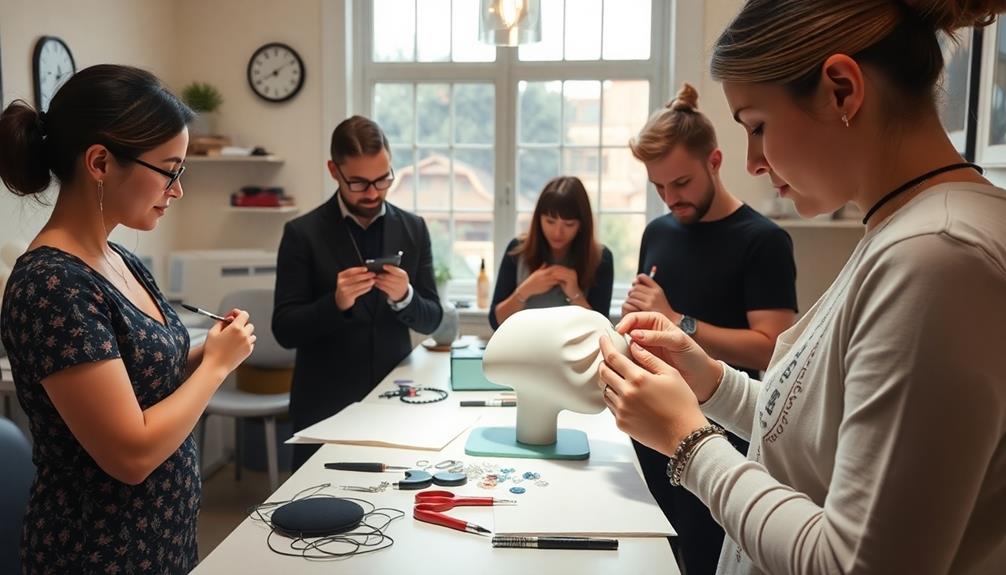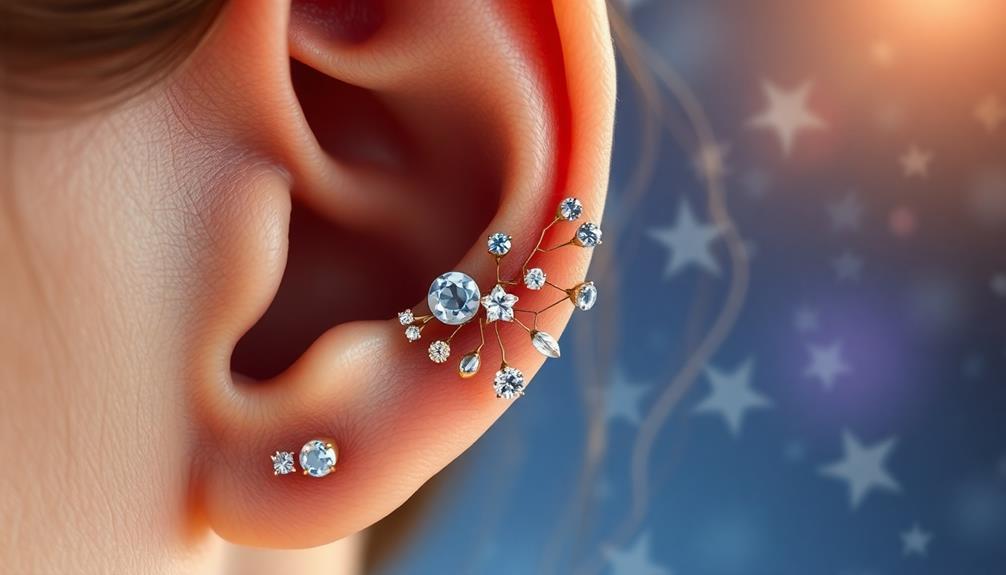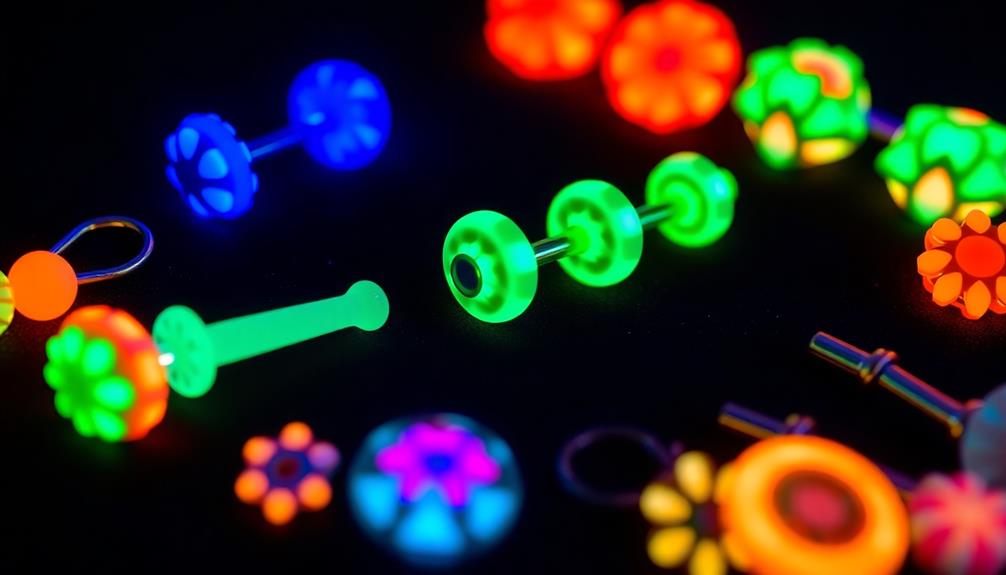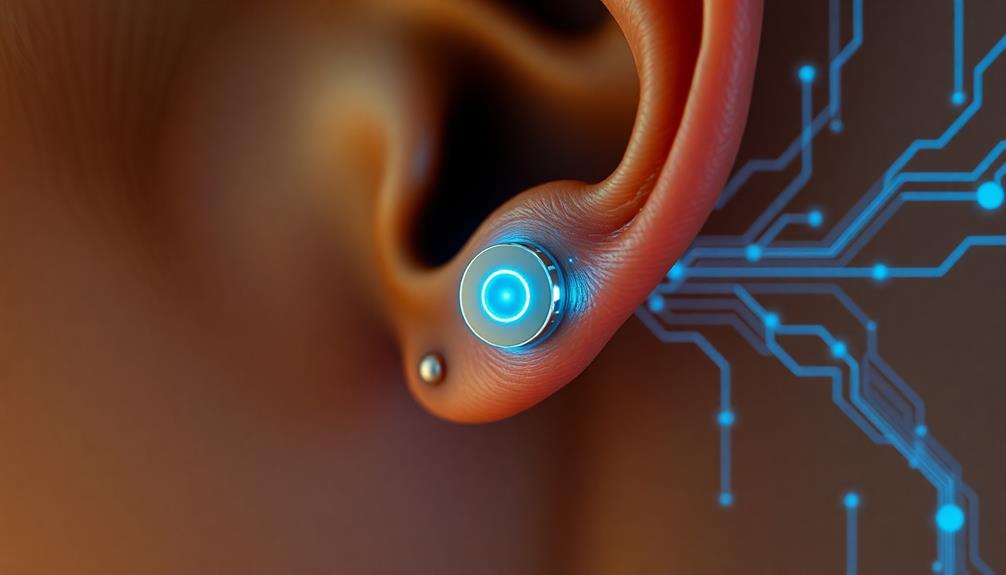When complimenting someone's piercings, focus on specific designs or colors to show appreciation for their unique style. Ask open-ended questions about the meaning behind their piercings or their personal experiences with aftercare. This not only fosters deeper connections but also invites them to share their stories. It's crucial to respect personal boundaries, so gauge their comfort and avoid invasive questions. If someone seems uncomfortable, steer the conversation to uplifting topics. Engaging in genuine dialogue can make the interaction rewarding, and you'll find there's much more to explore about personal style and body art's significance.
Key Takeaways
- Offer genuine compliments on specific design details to show appreciation for their personal style and choices in piercings.
- Inquire about the personal meaning or story behind a piercing to foster deeper connections and encourage sharing.
- Ask open-ended questions about their healing process or aftercare routine to show interest in their experience and insights.
- Respect personal boundaries and avoid invasive questions; focus on positive dialogue rather than assumptions or stereotypes.
- Use light-hearted responses to deflect negativity and steer conversations toward uplifting topics about body art and individual expression.
Understanding Piercing Motivation

Often, people choose piercings as a way to express their unique style and personality. You might find that many individuals see piercings as an essential part of their body art, allowing them to showcase their taste in fashion.
It's important to recognize that some piercings carry significant backstories or cultural meanings, while others might stem from spontaneous decisions reflecting their evolving identity.
Understanding the motivations behind someone's piercings can deepen your appreciation for their choices. You may notice that for some, piercings represent a form of self-expression, while for others, they might signify personal milestones or connections to their heritage.
The variety of jewelry options available means that each person's style can be as unique as their story.
As you engage in conversations about piercings, keep in mind that the philosophy surrounding body modification emphasizes subjective beauty. Everyone has different preferences, and acknowledging that can enhance your discussions.
Appropriate Compliments to Offer
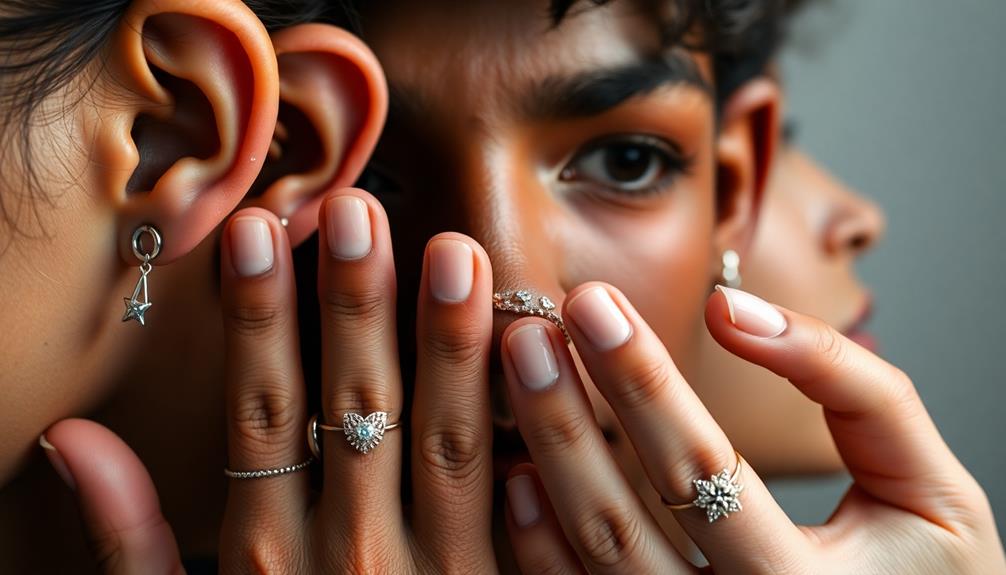
It's common to feel unsure about how to compliment someone on their piercings, but a thoughtful approach can make a big difference. Your compliments don't need to be elaborate; they just need to show that you appreciate their body jewelry.
Here are some tips to guide you:
- Highlight the Design: Mention specific details, like, "I love that unique design of your nose piercing!" This shows you're paying attention to their personal style.
- Acknowledge Their Commitment: You could say something like, "You must be really good at aftercare; that piercing looks amazing!" This not only compliments their body jewelry but also recognizes the effort they put into maintaining it.
- Celebrate Personal Stories: If you know there's a story behind their piercing, a comment like, "What inspired you to get that particular piercing?" can create a deeper connection and show genuine interest.
These thoughtful compliments foster positive interactions and make the person feel valued, encouraging them to share more about their experiences.
Open-Ended Questions to Ask

When you're admiring someone's piercings, asking open-ended questions can spark engaging conversations and reveal deeper insights about their choices. Instead of simple yes-or-no queries, opt for questions that encourage storytelling and personal expression.
For instance, you might ask, "What does your piercing represent for you?" This question invites the person to share their personal meaning behind their body jewelry, providing a glimpse into their individuality.
You could also inquire about their experience with the piercing process by asking, "How was the healing process for you?" This shows genuine interest in their journey and might uncover helpful tips on aftercare.
If you're curious about their future plans, try asking, "Do you have plans for more piercings in the future?" This opens the door for discussion about their aspirations and preferences in body jewelry.
Lastly, consider asking, "What advice would you give someone considering a similar piercing?" This can't only provide valuable insights but also foster a supportive dialogue.
Respecting Personal Boundaries

Respecting personal boundaries is essential in any conversation about piercings. When you admire someone's body jewelry, you want to create a positive environment without making them uncomfortable. Here are three key points to keep in mind:
1. Focus on Compliments: Instead of asking invasive questions, offer genuine compliments. Say something like, "I love your nose piercing; it really suits your style." This keeps the interaction light and enjoyable.
Additionally, recognizing the importance of self-awareness in conversations can help you be more attuned to how your words affect others.
2. Mind Body Language: Pay attention to the other person's body language. If they seem uncomfortable or unresponsive, gracefully shift the conversation to a different topic.
It's vital to respect their feelings and comfort level.
3. Avoid Assumptions: Don't make generalizations or assumptions about their piercing experience based on stereotypes.
Everyone has their own reasons for their body modifications, and it's respectful to recognize their right to privacy. Avoid asking about pain or healing unless they share that information willingly.
Navigating Unwanted Comments

Maneuvering unwanted comments about your piercings can be tricky, but it doesn't have to dampen your spirit. When faced with negativity, remember to stay true to yourself and your personal choices. A light-hearted response can often defuse tension. For example, saying, "I'll take that as the compliment you intended" can help redirect the conversation.
Pay attention to body language, too. If someone seems uncomfortable discussing piercings, it's best to change the subject. Here's a quick reference table to help navigate these situations:
| Situation | Response Type | Example Response |
|---|---|---|
| Complimenting | Positive Inquiry | "I love your earrings! What's your favorite piece?" |
| Negative Comment | Light-hearted Response | "Thanks for noticing! It's a bold choice!" |
| Intrusive Question | Shift the Focus | "I appreciate your curiosity, but I prefer to talk about something else." |
| Uncomfortable Vibe | Change the Topic | "So, what do you think about the latest movie?" |
| Respecting Boundaries | Acknowledgment | "I understand it's not for everyone, but I love it!" |
Confidently embrace your style, and don't hesitate to steer conversations in a positive direction.
Discussing Piercing Care and Healing
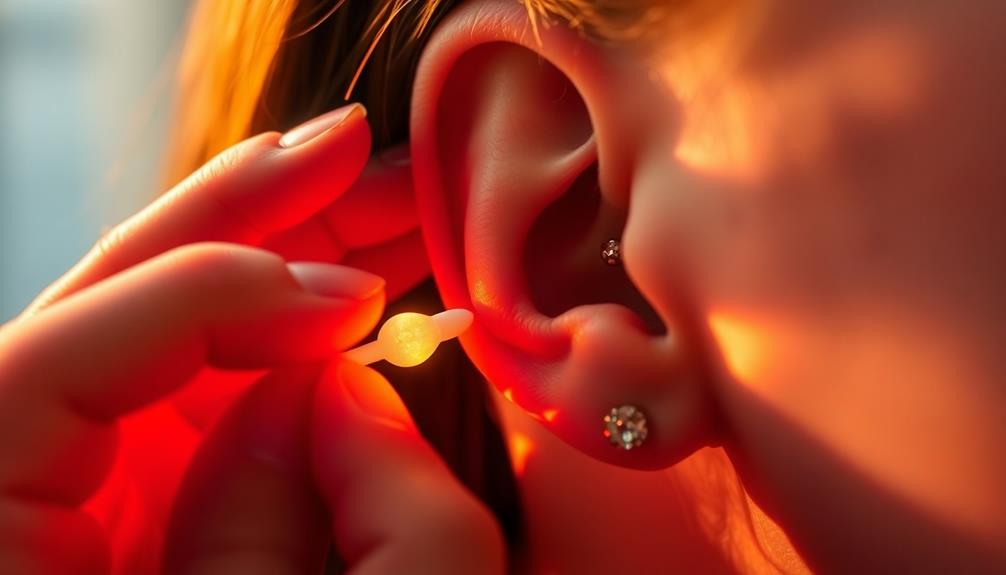
Taking care of your new piercing is essential for a smooth healing process, which can take several weeks or even months.
You'll want to follow your piercer's aftercare instructions closely, as different piercings have unique needs.
Additionally, choosing the right jewelry material can make a significant difference in how well your piercing heals.
Aftercare Instructions Importance
Proper aftercare instructions are vital for the healing process of your new piercing. Following these guidelines helps prevent infections and guarantees that your body piercings heal properly.
Just like with pets, understanding proper care routines is essential for health and well-being; for instance, ultimate hamster care emphasizes the importance of regular maintenance for a healthy environment.
The healing period can vary, but with attentive aftercare, you can achieve better results.
Here are three key aftercare tips you should follow:
- Clean Regularly: Use a saline solution or a recommended aftercare product to clean your piercing at least twice a day. This helps remove dirt and bacteria that can lead to complications.
- Avoid Touching: Keep your hands off your piercing, especially if they aren't clean. Touching can introduce harmful pathogens, risking infection and prolonging the healing process.
- Watch for Red Flags: Be aware of signs of infection, such as excessive redness, swelling, or discharge. If you notice these symptoms, contact your professional piercer right away for advice.
Healing Time Expectations
When it comes to healing time expectations for your new piercing, understanding the variability is key. Healing times can differ markedly depending on the type of body piercing you choose. For example, a nostril piercing typically heals in about 2 to 4 months, while a cartilage piercing might take anywhere from 4 to 12 months to become fully healed.
During the initial healing phase, expect some swelling and tenderness, especially in the first few weeks. It's essential to follow the aftercare guidelines provided by your piercer. Regular cleaning and avoiding irritants will promote proper healing and minimize complications.
As you progress through the healing time, keep an eye out for any signs of infection, such as excessive redness, discharge, or increased pain.
Remember, individual factors like skin type, lifestyle, and the piercing's location can influence healing. So, personalize your care routine based on your specific needs.
Jewelry Material Considerations
As you focus on healing your new piercing, selecting the right jewelry material is just as important for your overall experience. Choosing the wrong material can lead to irritation and hinder your healing process. It's also wise to take into account potential allergies and sensitivities, as certain materials can exacerbate skin reactions.
Here are three key considerations for picking the best jewelry:
- Opt for Titanium or Surgical Stainless Steel: These materials are hypoallergenic and reduce the risk of allergic reactions, making them ideal for new piercings. Additionally, using essential oil safety practices can help guarantee that you avoid any irritants during the healing process.
- Choose Nickel-Free Options: If you're sensitive to nickel, avoid jewelry containing this metal. Nickel can cause irritation and delay your healing, so always check for nickel-free labels.
- Confirm Proper Thickness and Length: The jewelry's size must match the piercing location for comfort and ideal healing. Ill-fitting jewelry can cause complications and may prolong the healing time.
Remember to check your jewelry regularly during the healing period for any signs of irritation or infection.
High-quality, non-toxic jewelry without coatings that can wear off is essential for a smooth healing journey. Prioritize these material considerations to enjoy your piercing to the fullest!
Engaging in Meaningful Conversations

Engaging in meaningful conversations about piercings can deepen connections and foster understanding. When you compliment someone's piercings, be genuine. A simple, "I love how your septum piercing complements your style," can start a positive exchange.
To keep the conversation flowing, ask open-ended questions like, "What inspired you to get that particular piercing?" This invites them to share more and opens the door for deeper discussion.
Always be mindful of personal boundaries. Avoid probing questions about pain or healing unless they seem comfortable discussing those topics. Respecting these limits shows you care about their comfort and fosters trust.
Sharing your own piercing experiences can also enhance the dialogue. Mention a favorite piercing you have and why it's meaningful to you. This not only creates a connection but also encourages the other person to share their stories.
Lastly, consider the setting and timing. Make sure it's an appropriate moment for this conversation. If they seem open, you'll find that discussing piercings can lead to enriching exchanges and create lasting bonds.
Frequently Asked Questions
Which Piercing Looks Attractive?
When considering which piercing looks attractive, it really depends on your personal style and facial features. Nostril and septum piercings often enhance appearance, while minimalist jewelry can elevate their overall appeal. Choose what resonates with you!
How Do I Ask for Another Piercing?
When you're ready for another piercing, research your options first. Consult a professional piercer, discuss placement and healing, and communicate any allergies. Respectful inquiries show you're informed and considerate about the process.
What Does Psychology Say About Piercings?
Psychology suggests piercings empower you, enhancing self-esteem and individual expression. They can trigger endorphins, creating euphoria, while societal perceptions may label you adventurous. Ultimately, your choices reflect your identity and personal beliefs.
Is It Rude to Not Tip a Piercer?
Imagine a world where gratitude flows freely. Not tipping a piercer can come off as ungrateful, especially since they rely on tips for income. Acknowledging their skill with a minimum 20% makes a difference.
Conclusion
In the world of piercings, every adornment tells a story, like a constellation of stars in the night sky. By understanding the motivations behind these choices and approaching conversations with respect and curiosity, you can create genuine connections. Complimenting and asking about someone's piercings opens doors to meaningful exchanges, allowing you to navigate personal boundaries gracefully. So, next time you see a piercing that catches your eye, remember to shine your light with kindness and tact.
Hi, my name is Danielle, and I’m an author for piercings-body.com. I have a passion for writing and love to share my knowledge on all things body piercing-related. I’m also a huge advocate for safe body modification practices and believe everyone should be able to make informed decisions about their bodies. When I’m not writing or blogging, I enjoy spending time with my family and friends, practicing yoga, and exploring new places.


